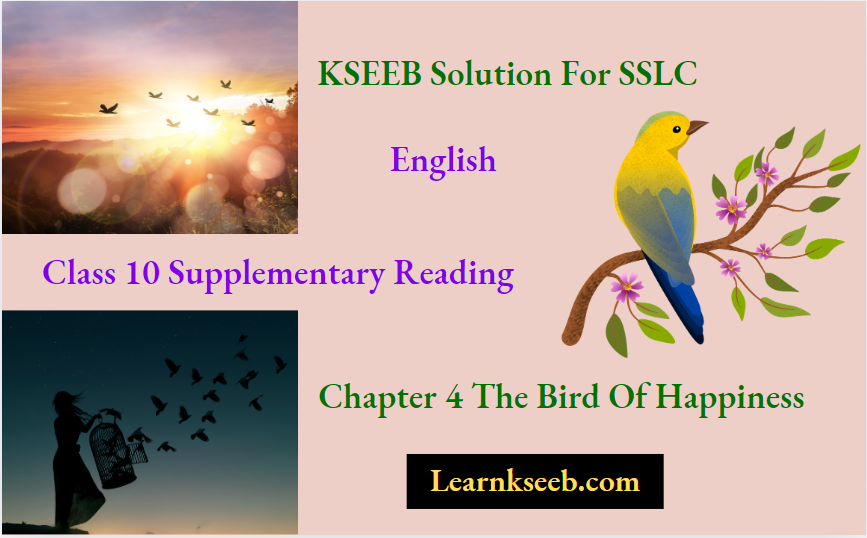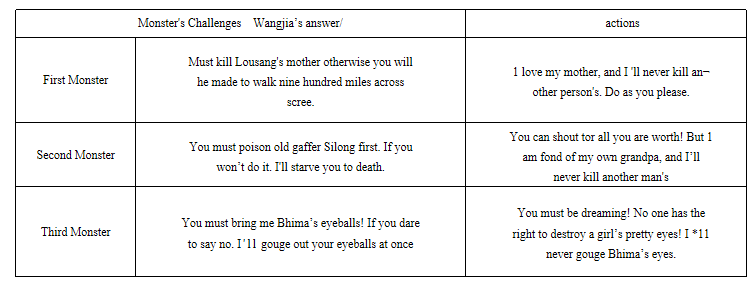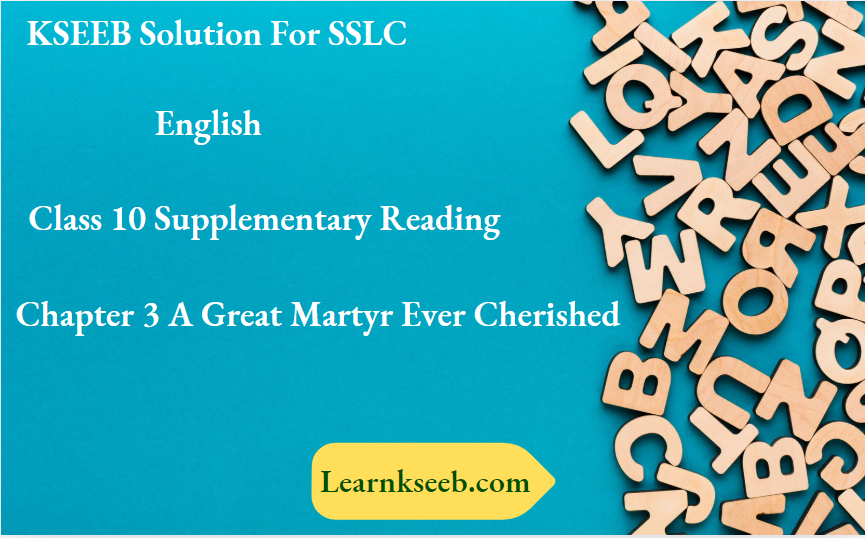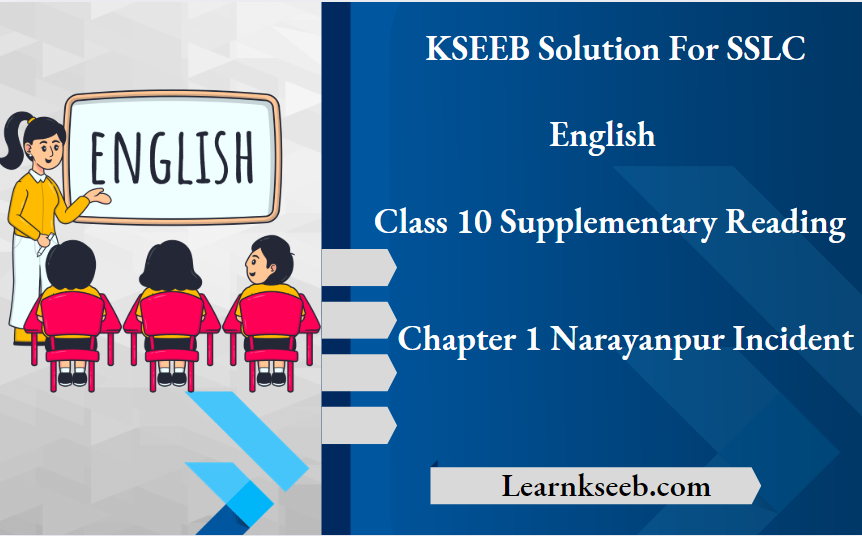KSEEB solution for SSLC English Class 10 Chapter 4 The Bird Of Happiness Textual Exercises
Question 1. “Will I ever make it?” Why did Wangjia feel so?
Answer: Wangjia felt that he would not be able to complete his journey because of the following reasons. After the first hundred miles, the soles of Anglia’s boots were ripped apart by the stones; after the second hundred miles, his feet were cut to pieces; and after the third hundred miles, his hands were torn to shreds.
Question 2. What hardships did Wangjia undergo on his way to find the Bird?
Answer: Wangjia had to undergo many hardships on his way to find the Bird. The first monster made the smooth road a vast scree. Every stone on it was as sharp as a knife. By the end of his first journey, his feet were cut to pieces and his hands were torn to shreds. Wangjia crawled forward and his clothes were torn, and his knees and shoulders were bruised. In his second journey, the second monster turned the blue mountains and rivers into a boundless desert. By the end of three hundred miles, he was so hungry that there was a sharp pain in his guts as if they were being cut by a knife. Wangjia went to a river, drank plenty of cold water, and continued on his way. By the time he reached his journey’s end, he was nothing but skin and bone. Wangjia lost his eyes to the third monster. Groping his way with his hands on the ground, Wangjia crawled another nine hundred miles. Thus Wangjia faced a very hard ordeal in order to meet the Bird of Flappiness to earn prosperity for his people.
Question3. Changes came over Wangjia as the Bird of Happiness caressed him.
Answer: The Bird of Happiness caressed Wangjia gently with its wings and sang for him. His eyeballs flew back to their sockets, and now he saw much more brightly than before. All his wounds were healed and he was stronger than ever. The Bird of Happiness offered Wangjia some dried meat and cream cake and then bore him back to his home village.
Question4. Wangjia was face to face with three monsters. Each monster had his own wish. Wangjia too had a wish. What contrast do you draw between the wishes of the monster and the wish of Wangjia? What does the folktale suggest with this contrast?
Answer: All three monsters were cruel in nature. They were violent in nature and wished for destruction. In contrast, Wangjia wished for peace, integrity, and the well-being of his people. He risked his life and underwent severe hardships in order to earn happiness for his people. Wangjia was the epitome of courage, patience, humility, peace, integrity, and sacrifice where as the three monsters symbolize violence, cruelty, difficulties, and problems.

Question5. Read paragraphs 1 and 28 and 29. What do you understand from them about the meaning of real happiness?
Answer: For any civilization, real happiness lies in living in harmony with other aspects of nature. People or societies need basic necessities like water, plants, trees, and other aspects of nature to make their society prosperous. Along with these one needs the attributes of courage, patience, humility, and a sense of sacrifice for the well-being of society.
Question6. What do you like the most in the story? Support your answer by giving reasons.
Answer: The replies given by Wangjia to the orders of the three monsters is the best part of the story. Wangjia was very much focused on his aim. He did not bother to undergo the cruelty of the monsters and stuck to his wishes. He underwent intolerable turmoil but did not like to trouble others or innocents to make his journey easy. Therefore all his hardships were paid in the end with peace and prosperity due to his good intentions.
Question7. Read the story. Discuss with your Partner and fill in the table given below.

Class 10 English The Bird Of Happiness More Activities On Comprehension And Composition
Question 1. The people of a very poor area in Tibet suffered from hunger and cold all year round but still they
1)Were happy and contended
2)Believed that happiness exists somewhere in the world
3)Hoped that Wangjia would solve their problem
4)Hoped that the bird of happiness would solve their problem
Answer: 2) Believed that happiness exists somewhere in the world
Question 2. The three old monsters could
1)Kill a man by simply blowing through their long beard
2)Bring the bird of happiness anywhere they wanted
3)Stop anybody from meeting the bird of happiness
4)Not do anything to stop Wangjia from meeting the bird of happiness
Answer: 1) Kill a man by simply blowing through their long beard
Question 3. The first monster would kill Wangjia by
1)Blowing him through his beard
2)Starving him without food and water
3)Cutting his hand and feet
4)Making him walk nine hundred miles across scree
Answer: 4) Making him walk nine hundred miles across scree
Question 4. Every stone on it was as sharp as a knife. The figure of speech used here is
1) Metaphor
2) Personification
3) Simile
4) Synecdoche
Answer: 3) Simile
Question 5. Wangjia told the second monster that he was fond of his grandpa because
1)The monster asked him
2)The monster ordered him to poison old gaffer Silong
3)Wangjia wanted the monster to know how much he loved his grandpa
4)They were talking about their grandparents
Answer: 2) The monster ordered him to poison old gaffer Silong
Question 6. Wangj could not bring himself to turn back home as
1)He knew that the monster would not allow him to go
2)His people would not accept him without the bird of happiness
3)He was very tired to do so
4)He knew that his people were expecting him to return with the bird of happiness
Answer: 4) He knew that his people were expecting him to return with the bird of happiness
Question 7. This must be his last ordeal. ‘Ordeal’ means
1) Suffering
2) Chance
3) Journey
4) Destination
Answer: 1) Sufferings
Question 8.’touched gently with love’. The one-word alternative for the phrase is
1)Bang
2) pat
3) Caress
4) Handle
Answer: 3) caress
Question 9. He could see much more brightly than before. The ‘brightly’ is
1)A noun
2) An adjective
3) A verb
4) And adverb
Answer: 4) an adverb
Question 10. The character of Wangjia depict
1)Strength
2) perseverance
3) Selflessness
4) All the three
Answer: 4) all the three
Complete the similes, metaphors, and personifications that are picked up from the lesson and name them.
Question 1. A large mountain covered with snow shone.
Answer: silver-simile
Question 2. like a crow.
Answer: an old monster with a black beard – simile
Question 3. on it was as sharp as a knife.
Answer: Every stone- simile
Question 4. His head and he began to
Answer: swim, see stars – a metaphor
Question 5. They broke through the clouds.
Answer: golden sun – personification
Question 6. Acme down from the sky.
Answer: warm breeze – personification
Question 7. Old brown bearded monster with a voice
Answers: like the whistling wind – simile
KSEEB Class 10 English Chapter 4 The Bird Of Happiness Read The Following Extracts Carefully And The Questions That Follow
Question 1)What does the word ‘despite’ refer to?
Answer: ‘Despite’ refers to the sufferings of the people of an area in Tibet
Question 2)How did happiness exist according to them?
Answer: Happiness was a beautiful bird
Question 3)Where did happiness exist according to them?
Answer: Happiness existed on a snowy mountain far, far away in the east
Question 4)Who went in search of happiness?
Answer: Wangjia, an extremely bright boy went in search of the happiness
2. ‘I’ll never kill another person. Do as you please! ’
Question 1)Who is the T and ‘you’?
Answer: T refers to Wangjia and ‘you’ refers to the old black-bearded monster
Question 2)Who is the ‘another person referring to?
Answer: Lang’s mother
Question 3)Why did the person say that he would never kill another person?
Answer: because he loved his own mother so he would not kill another’s mother
Question 4)How was the person punished?
Answer: Wangjia was made to walk nine hundred miles across scree
3 This must be the last ordeal’.
Question 1)Whose ordeal was it?
Answer: Wangjia’s
Question 2)What was the ordeal?
Answer: The ordeal was to crawl nine hundred miles in blindness
Question 3)What is the meaning of the word ‘ordeal’?
Answer: ordeal means suffering
KSEEB SSLC English Chapter 4 The Bird Of Happiness The Following Questions Briefly
Question1. What did the old folk say about happiness?
Answer: The old folk said that happiness was a beautiful bird living on a snowy mountain far, far away in the east.
Question2. In what way was the bird guarded?
Answer: The Bird of Happiness was said to be guarded by three old monsters, who could kill a man by simply blowing through their long beards.
Question3. Why did Wangjia decide not to go back?
Answer: Wangjia decided not to go back because he knew that the people at home were waiting for him to bring back happiness.
Question4. The first monster made Wangjis walk a long way. How did the second monster make him suffer?
Answer: The second monster blew through Iris’s long beard, and Wangjia’s bread bag flew into the sky. The blue mountains and green rivers were turned into a boundless desert with no scrap of food to be found. Wangjia had to starve severely all along the way. By the time he reached his journey’s end, he was nothing but skin and bone.
Question5. How was the last journey of Wangjia different from the previous one?
Answer: The previous that is the second journey of Wangjia was with hunger. He had to starve without food and water. His last journey was without eyes. His eyes were gouged out by the third monster. He groped his way with his hands on the ground and crawled his way in the direction of the rising sun.



